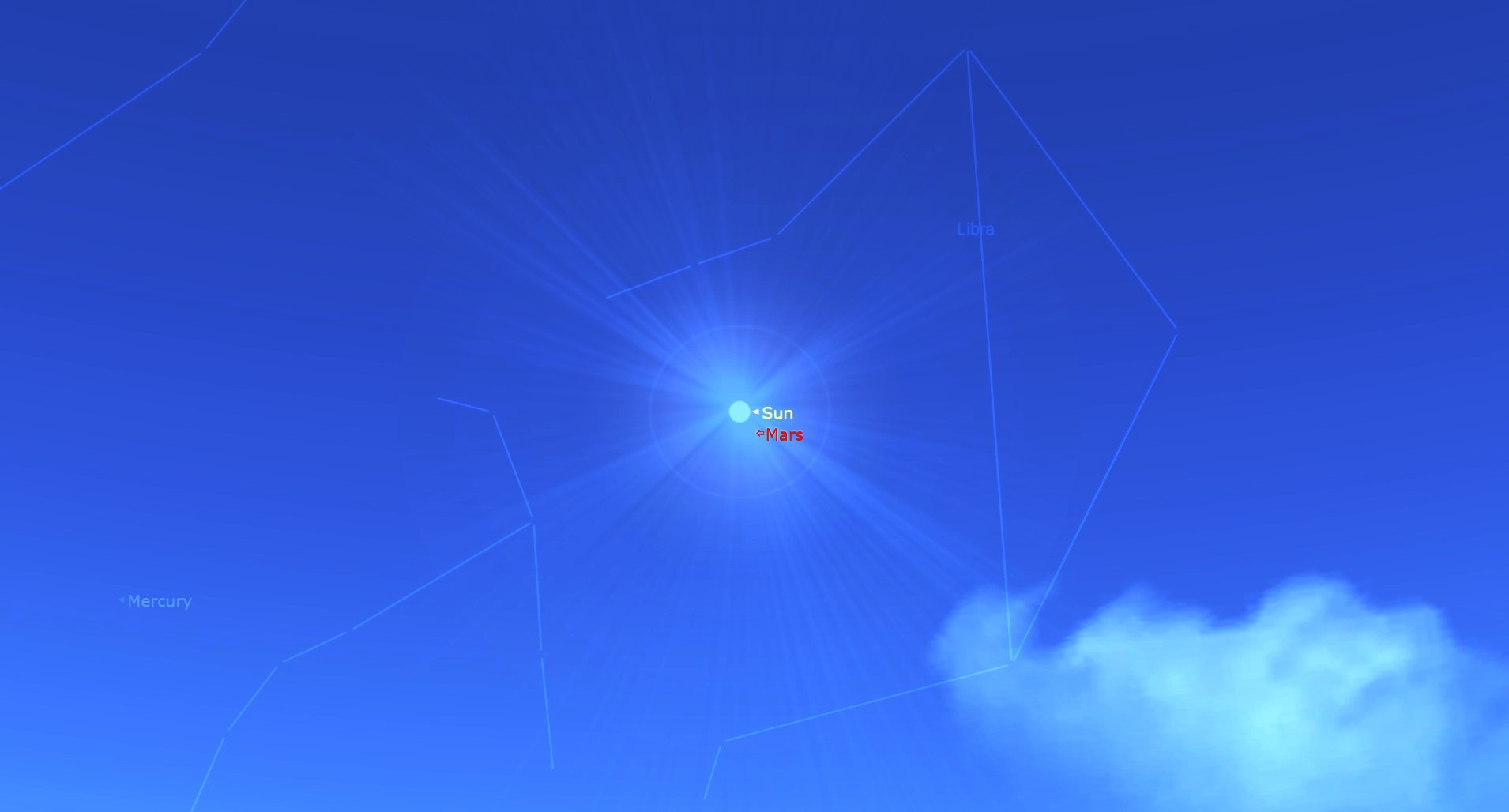Say goodbye to Mars! The Red Planet hides behind the sun for 2 weeks
The Red Planet will be at solar conjunction this weekend as its orbit takes it to the far side of the sun and out of sight for weeks.

Mars will disappear from the sky over Earth on Saturday (Nov. 18) when the Red Planet is apparently swallowed by the sun.
Don't panic, this disappearance may look dramatic but it is actually the result of Mars passing to the opposite side of the sun to Earth during an event that astronomers call solar conjunction.
According to In the Sky, Mars will be separated from the sun by just less than one degree as it makes its close approach to the star. Both bodies will be in the constellation of Libra. After this, the Red Planet will be unobservable for several weeks as it is washed out by the glare of our star.
During the solar conjunction, an event which Earth and Mars experience every two Earth years, the two planets — the third and fourth from the sun, respectively — will also be at their greatest separation. Mars and Earth are usually separated by an average distance of around 140 million miles (225 million kilometers). During the solar conjunction Earth and Mars will be separated by around 235 million miles, over two and half times the average distance between our planet and the sun.
Related: NASA's Mars robots are on their own right now — here's why

Get a good look at the night sky while you wait for Mars to return! We recommend the Celestron Astro Fi 102 as the top pick in our best beginner's telescope guide.
The solar conjunction of Mars isn't just significant to skywatchers. For over twenty years NASA has operated robots like the Curiosity and Perseverance rovers on the surface of Mars as well as flying the Ingenuity helicopter over its barren and arid vistas, and of course spacecraft in orbit around the Red Planet.
Over the next few months Mars will emerge from the wide side of the sun and will be visible for longer and longer periods in the sky prior to dawn. In around a year it will reach opposition, at which time Mars will be visible for most of the night over Earth.
Get the Space.com Newsletter
Breaking space news, the latest updates on rocket launches, skywatching events and more!
During the solar conjunction, mission controllers on Earth will lose contact with robotic Mars missions. Rovers will grind to a halt, Ingenuity will be grounded, and spacecraft will not beam data back to Earth. This is done to prevent the possibility of a partial command getting through that interferes with operations of the robots or spacecraft.
"NASA will hold off sending commands to its Mars fleet for two weeks, from Nov. 11 to 25, while Earth and the Red Planet are on opposite sides of the sun. Called Mars solar conjunction, this phenomenon happens every two years," NASA said in a statement. "The missions pause because hot, ionized gas expelled from the sun's corona could potentially corrupt radio signals sent from Earth to NASA's Mars spacecraft, leading to unexpected behaviors."
Signals to Mars were halted on Saturday, Nov. 11 and will resume on Nov. 25. This won't be a holiday for Mars missions, which will continue to gather data about Mars surface conditions, weather and the movement of sand across the Martian surface.
"Our mission teams have spent months preparing to-do lists for all our Mars spacecraft," Mars Relay Network manager Roy Gladden said in the statement "We'll still be able to hear from them and check their states of health over the next few weeks."
Mars might be gone from the night sky, but there's still plenty of other awesome sights to check out. Need some optics to get an up-close look? Our guides to the best telescopes and best binoculars are a great place to start.
And if you're looking to take photos of the night sky while you wait for Mars to return, check out our guide on how to shoot the night sky, as well as our best cameras for astrophotography and best lenses for astrophotography.
Join our Space Forums to keep talking space on the latest missions, night sky and more! And if you have a news tip, correction or comment, let us know at: community@space.com.

Robert Lea is a science journalist in the U.K. whose articles have been published in Physics World, New Scientist, Astronomy Magazine, All About Space, Newsweek and ZME Science. He also writes about science communication for Elsevier and the European Journal of Physics. Rob holds a bachelor of science degree in physics and astronomy from the U.K.’s Open University. Follow him on Twitter @sciencef1rst.









